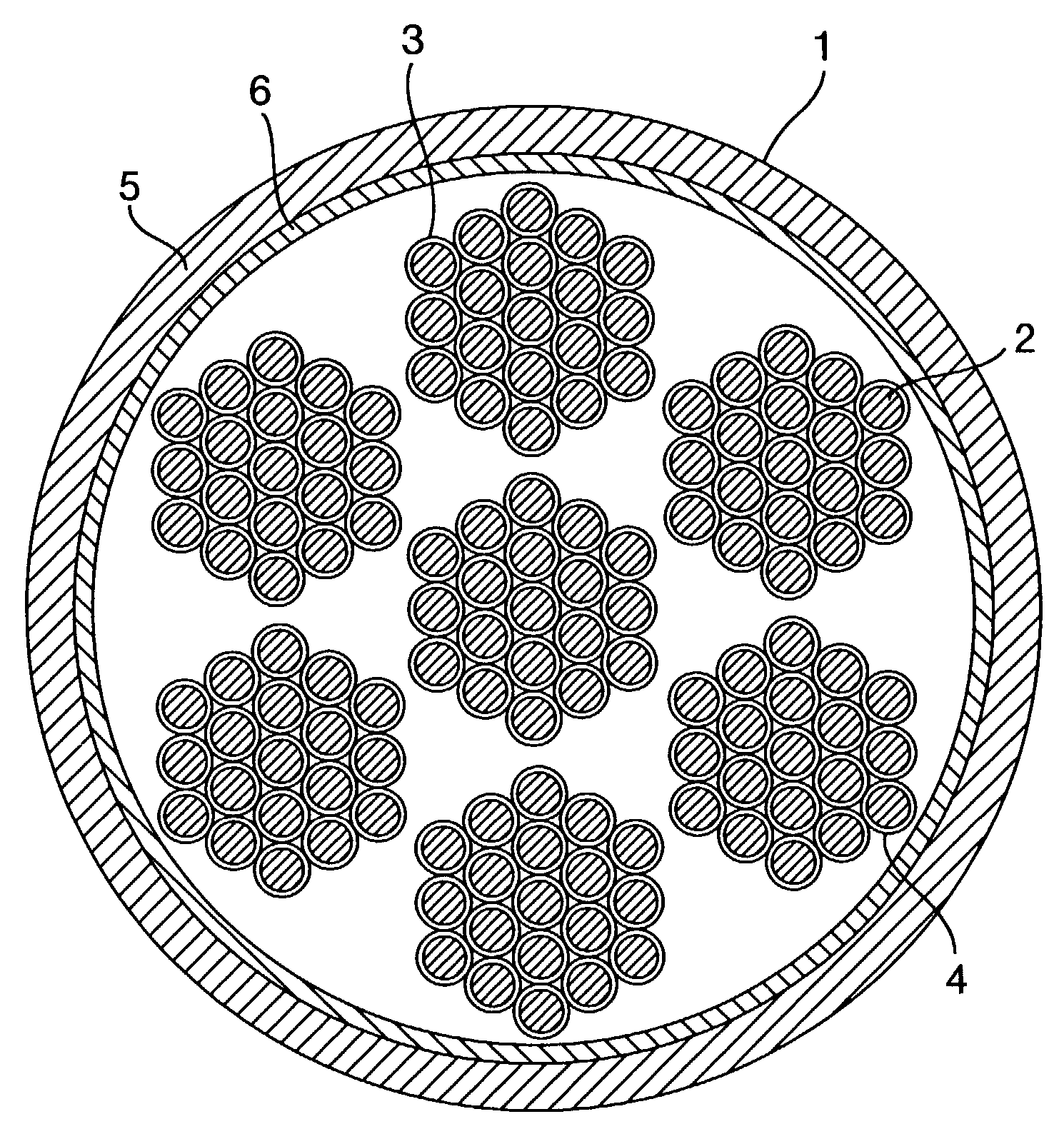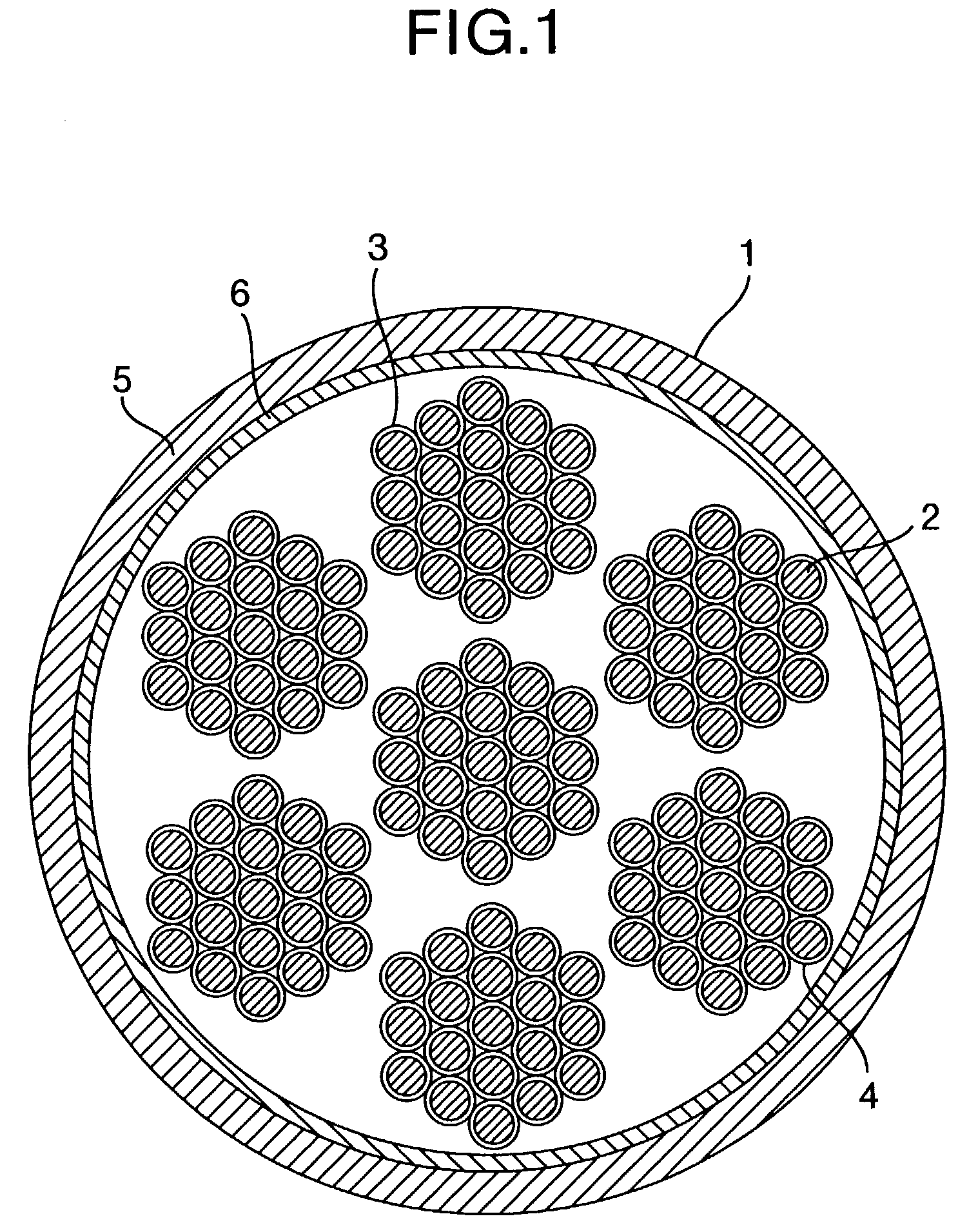Rope and elevator using the same
a technology of rope and elevator, applied in the direction of elevators, yarn, transportation and packaging, etc., can solve the problems of shortening the life of ropes and affecting comfor
- Summary
- Abstract
- Description
- Claims
- Application Information
AI Technical Summary
Problems solved by technology
Method used
Image
Examples
first embodiment
[0057]FIG. 8 is a perspective view of an elevator using the wire ropes described above. Further, FIG. 9 is a plan view showing an elevating passage in the present embodiment as viewed from the above.
[0058]A cage 51 of the elevator is supported by a rope 53 via under-cage pulleys 52. One end of the rope 53 is fixed to a building at a support point 54. The other end is fixed to the building at a support point 55 via the under-cage pulleys 52, a sheave 56, and a counterweight pulley 58 installed in a counterweight 57. Then, a driver 59 rotates the sheave 56 to drive the rope 53 by frictional force generated between the sheave 56 and the rope 53, thereby moving the cage 51 and the counterweight 57 in the vertical direction. The driver 59 is provided with a brake 60.
[0059]In FIG. 8, the driver 59 is shown as a gearless type driver comprising a single motor, but may be of a geared type driver using a reduction gear. As shown in FIG. 9, the cage 51 is regulated by guide devices 61 and cage...
second embodiment
[0076]FIG. 10 is a plan view of the elevator using the rope of the present invention. The present embodiment differs from the embodiment shown in FIG. 9 mainly in that the counterweight 57 is installed at a different position. That is, the counterweight 57 is installed between a side of the cage 51 located opposite the cage-side doors 72a and 72b and the elevating passage wall 64. Correspondingly, the under-cage pulley 52, sheave 56, and driver 59 are arranged at different positions. These differences in arrangement are resulted from the limitation of the layout of the building. As shown in FIG. 10, in the present embodiment, the longitudinal axes of the under-cage pulley 52 and sheave 56 extend in different directions, and the longitudinal axes of the sheave 56 and counterweight pulley 58 also extend in different directions. That is, the rope is twisted between the pulley 52 and the sheave 56 and further twisted between the sheave 56 and the counterweight 58. Hence, if a convention...
third embodiment
[0077]FIG. 11 is a perspective view of the elevator using the rope of the present invention. In the present embodiment, top pulleys 65 and 66 are used to install the sheave 56, driver 59, and brake 60 at the bottom of the elevating passage. A main advantage of this construction is that the driver 59, which has possibility to make noise in general, can be installed at the bottom of the elevating passage, where noise is hard to become a problem relatively, instead of the top of the elevating passage, where noise is easiest to resound. On the other hand, compared to the embodiment shown in FIGS. 8 and 9, the entire length and weight of the rope 53 become longer and heavier, and therefore, there is a problem that a large amount of time and labor for installation operation is required. However, when the rope of the present invention is used in this construction, obtained is an effect that weight of the entire rope is reduced and the installation operation becomes easy. That is, the prese...
PUM
| Property | Measurement | Unit |
|---|---|---|
| Diameter | aaaaa | aaaaa |
| Elastic modulus | aaaaa | aaaaa |
Abstract
Description
Claims
Application Information
 Login to View More
Login to View More - Generate Ideas
- Intellectual Property
- Life Sciences
- Materials
- Tech Scout
- Unparalleled Data Quality
- Higher Quality Content
- 60% Fewer Hallucinations
Browse by: Latest US Patents, China's latest patents, Technical Efficacy Thesaurus, Application Domain, Technology Topic, Popular Technical Reports.
© 2025 PatSnap. All rights reserved.Legal|Privacy policy|Modern Slavery Act Transparency Statement|Sitemap|About US| Contact US: help@patsnap.com



